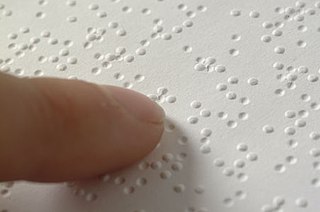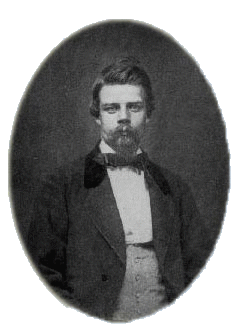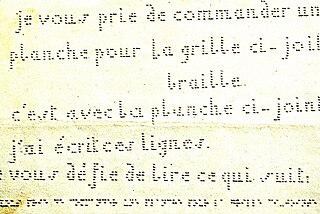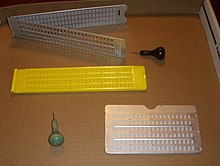
Braille is a tactile writing system used by people who are visually impaired, including people who are blind, deafblind or who have low vision. It can be read either on embossed paper or by using refreshable braille displays that connect to computers and smartphone devices. Braille can be written using a slate and stylus, a braille writer, an electronic braille notetaker or with the use of a computer connected to a braille embosser.

A braille embosser is an impact printer that renders text as tactile braille cells. Using braille translation software, a document or digital text can be embossed with relative ease. This makes braille production efficient and cost-effective. Braille translation software may be free and open-sourced or paid.

Louis Braille was a French educator and the inventor of a reading and writing system, named braille after him, intended for use by visually impaired people. His system is used worldwide and remains virtually unchanged to this day.

A stylus is a writing utensil or a small tool for some other form of marking or shaping, for example, in pottery. It can also be a computer accessory that is used to assist in navigating or providing more precision when using touchscreens. It usually refers to a narrow elongated staff, similar to a modern ballpoint pen. Many styluses are heavily curved to be held more easily. Another widely used writing tool is the stylus used by blind users in conjunction with the slate for punching out the dots in Braille.
The Moon System of Embossed Reading is a writing system for the blind, using embossed symbols mostly derived from the Latin script. It is claimed by its supporters to be easier to understand than braille, though it is mainly used by people who have lost their sight as adults, and thus already have knowledge of the shapes of letters.

The subject of blindness and education has included evolving approaches and public perceptions of how best to address the special needs of blind students. The practice of institutionalizing the blind in asylums has a history extending back over a thousand years, but it was not until the 18th century that authorities created schools for them where blind children, particularly those more privileged, were usually educated in such specialized settings. These institutions provided simple vocational and adaptive training, as well as grounding in academic subjects offered through alternative formats. Literature, for example, was being made available to blind students by way of embossed Roman letters.

New York Point is a braille-like system of tactile writing for the blind invented by William Bell Wait (1839–1916), a teacher in the New York Institute for the Education of the Blind. The system used one to four pairs of points set side by side, each containing one or two dots. The most common letters are written with the fewest points, a strategy also employed by the competing American Braille.
Night writing is the name given to a form of writing invented by Charles Barbier as one of a dozen forms of alternative writing presented in a book published in 1815: Essai sur Divers Procédés D'Expéditive Française, Contenant douze écritures différentes, avec une Planche pour chaque procédé. The term does not appear in the book, but was later applied to the method shown on Plate VII of that book. This method of writing with raised dots that could be read by touch was adopted at the Institution Royale des Jeune Aveugles in Paris.

The Perkins Brailler is a "braille typewriter" with a key corresponding to each of the six dots of the braille code, a space key, a backspace key, and a line space key. Like a manual typewriter, it has two side knobs to advance paper through the machine and a carriage return lever above the keys. The rollers that hold and advance the paper have grooves designed to avoid crushing the raised dots the brailler creates.

William Bell Wait (1839–1916) was a teacher in the New York Institute for the Education of the Blind who invented New York Point, a system of writing for the blind that was adopted widely in the United States before the braille system was universally adopted there. Wait also applied the New York Point principles to adapt them for use in over 20 languages, created a form of New York Point to notate music, and invented a number of devices to better type and print embossed material for the visually impaired.

Japanese Braille is the braille script of the Japanese language. It is based on the original braille script, though the connection is tenuous. In Japanese it is known as tenji (点字), literally "dot characters". It transcribes Japanese more or less as it would be written in the hiragana or katakana syllabaries, without any provision for writing kanji.

Charles Barbier de la Serre was the inventor of several forms of shorthand and alternative means of writing, one of which became the inspiration for Braille.

Valentin Haüy was the founder, in 1785, of the first school for the blind, the Institute for Blind Youth in Paris. In 1819, Louis Braille entered this school.

A tactile alphabet is a system for writing material that the blind can read by touch. While currently the Braille system is the most popular and some materials have been prepared in Moon type, historically, many other tactile alphabets have existed:

Institut National des Jeunes Aveugles, in Paris, was the first special school for blind students in the world, and served as a model for many subsequent schools for blind students.
Maurice de La Sizeranne (1857–1924), blinded at age 9, was an important figure in the movement to support the blind.
American Braille was a popular braille alphabet used in the United States before the adoption of standardized English Braille in 1918. It was developed by Joel W. Smith, a blind piano tuning teacher at Perkins Institution for the Blind in Boston, and introduced in 1878 as Modified Braille. In 1900 it was renamed American Braille.
Louis Braille's original publication, Procedure for Writing Words, Music, and Plainsong in Dots (1829), credits Barbier's night writing as being the basis for the braille script. It differed in a fundamental way from modern braille: It contained nine decades (series) of characters rather than the modern five, utilizing dashes as well as dots. Braille recognized, however, that the dashes were problematic, being difficult to distinguish from the dots in practice, and those characters were abandoned in the second edition of the book.

Decapoint, or raphigraphy, was a tactile form of the Latin script invented by Louis Braille as a system that could be used by both the blind and sighted. It was published in 1839. Letters retained their linear form, and so were legible without training to the sighted, but the lines were composed of embossed dots like those used in braille. Each letter contained ten dots in the height and different dots in the width to produce the graphic form of print.
Thomas Mark Lucas was a British educator of the blind, founder of the Royal London Society for Blind People, and developer of the Lucas tactile alphabet system, an alternative to the Braille system of reading for the blind.















